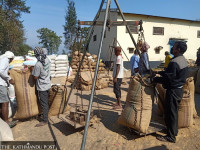Money
Apple growers in highlands celebrate bumper harvest
Farm incomes have more than doubled after the roadless villages were connected to the highway network.
Aash Gurung, DB Budha & Raj Bahadur Shahi
Apple growers in Nepal's northern highlands are celebrating a bumper harvest this season. Fruit farming has raised incomes and living standards in the mountain villages.
In the central Nepal district of Lamjung, apple production is reported to have doubled. In Jumla and Mugu in the far west, output is expected to drop. But the rise in prices of apples will offset any loss in income to the farmers, analysts say.
Farm incomes have more than doubled after the roadless apple-producing villages in the mountain districts were connected to the highway network.
“I have already sold around 500 kg of apples in Besisahar,” said Arbin Gurung of Tachai, Lamjung who has 1,100 apple trees in his orchard. He says a fresh batch of 400 kg of apples is ready to be dispatched to market.
Gurung can get Rs200 per kg for his apples in the market while the farmgate price is nearly half that.
Another apple grower Som Raj Gurung says he has started picking the Gala variety of apples in his orchard. “Other varieties such as Golden and Fuji will be harvested after a couple of weeks.”
Sol Bahadur Gurung, who owns two orchards in Tachai and Nasku, has sold 900 kg of Gala apples. According to local farmers, the Gala variety has ripened earlier than other varieties this year.
Farmers in Manang, which lies at an elevation of 3,519 metres above sea level, grow Fuju, Jona Prince, Red Delicious and other types of apples.
Sol Bahadur hopes to harvest another 3,000 kg from his two orchards.
The majority of locals in the villages are attracted to apple farming. Tisi Lama and his four partners planted 2,500 apple saplings of different varieties. This year, around 2,300 plants have started yielding fruit.
“We have already started harvesting the Gala variety to send to Kathmandu,” said Lama. He expects to harvest around 2,500 kg of Gala apples from his farm this season.
Former Member of Parliament Polden Chhopang Gurung is credited with introducing commercial apple farming in Manang by bringing improved varieties of the fruit from Italy and Serbia five years ago.
Gurung’s Agro Manang Farm is currently growing apples on 735 ropanis in Bhartang in Manang Ngisyang Rural Municipality-1.
Rajeshwar Silwal, acting chief of the Agriculture Knowledge Centre in Manang, says a majority of farmers in Lower Manang are engaged in commercial apple farming using the high-density technique.
In the traditional method, apple trees are planted 5-7 metres apart whereas in the high-density method, the plants are placed 1 metre apart. Under this method, around 400 plants can be planted in a hectare compared to 178 plants in the traditional method.
The high-density method yields 40 to 60 tonnes per hectare while farmers can get only 6 to 8 tonnes in the conventional method. The new technique eases orchard intercultural operations, plant protection and harvesting and yields quality produce.
The apple varieties used in high-density farming are Jeromine, Red Velox, Red Cap Valtod, Scarlet Spur-II, Super Chief, Gale Gala, Redlum Gala and Auvil Early Fuji.
“Apple farming can be done at altitudes of 2,000 to 3,500 metres,” said Silwal. “Farmers in Lower Manang have been marketing the apples grown in the area with their effort.”
According to the Agriculture Knowledge Centre, Manang, farmer grew around 2,200 tonnes of apples on 3,65 hectares in the district last year.
“Production is expected to rise by 10 percent this year,” said Silwal.
Last year, the Directorate of Agriculture Development Gandaki Province distributed 13,540 apple spellings to locals of Manang at a 75-percent subsidy.
Besides Manang, farmers in Mustang, Jumla, Solukhumbu, Gorkha, Kalikot and Mugu have been engaged in commercial apple farming using the high-density technique.
Agriculture experts say that importing saplings for high-density farming is costlier, and there is a risk of bringing new plant diseases too.
In Jumla, Ratan Rawat's apple orchard has become a centre of attraction. The fruits on 200 trees have ripened and turned the entire orchard red.
“Even though output is less than last year, the apples are larger in size. The quality is better this year too,” said Rawat.
Last year, he supplied his apples to markets in Butwal and Narayanghat. But this year, buyers from Dang are visiting his farm. “They have offered Rs60 per kg.”
Rawat expects to pick 1,000 kg of apples this year. He has 300 trees of Red, Royal and Golden varieties. Among them, 200 trees have started yielding fruit.
Rawat and other apple growers in Jumla and Mugu are busy harvesting their apples. Domestic tourists are also visiting the apple orchards.
Local farmers have been drawn to commercial apple farming, and they have planted new saplings on 4,250 hectares this year.
Villages such as Talcha, Maitulek, Ghattalekh, Baam, Foipata, Dakhryalbada, Jhapagard, Mathitum, Pina, Jhyari and Kotila in Chhayanath Rara Municipality are considered a pocket zone for apple production.
According to the District Agriculture Development Office in Mugu, around 5,000 farmers in the district are engaged in commercial apple farming.
In Jumla, growers have reported a drop in output this year. Kanna Singh Baduwal of Baamgaau said that production this year was not satisfactory.
Baduwal has planted around 800 trees on 7 ropanis, out of which, 400 trees are bearing fruit this year. He sold around 5 tonnes of apples for Rs45 per kg last year.
“We have started getting a better price for our apples as our village has been connected by road. But the decreasing quantity of apples each year is worrisome,” Baduwal said.
Jun Bahadur Khadka, chief of Chhayanath Rara Municipality-14, says that apple production is decreasing due to lack of irrigation facilities. “The plants also lack care,” he said.
According to the Agriculture Development Office in Mugu, around 270 tonnes of apples were produced in the district last year. Two years ago, production amounted to 340 tonnes.
Chandra Bahadur Shahi, chief of the Agriculture Development Office in Mugu, said that increasing infestation of pests such as hairy caterpillars had resulted in lower productivity.
“Untimely and inadequate rainfall has also affected production,” he said.




 7.12°C Kathmandu
7.12°C Kathmandu.jpg)

.jpg)













